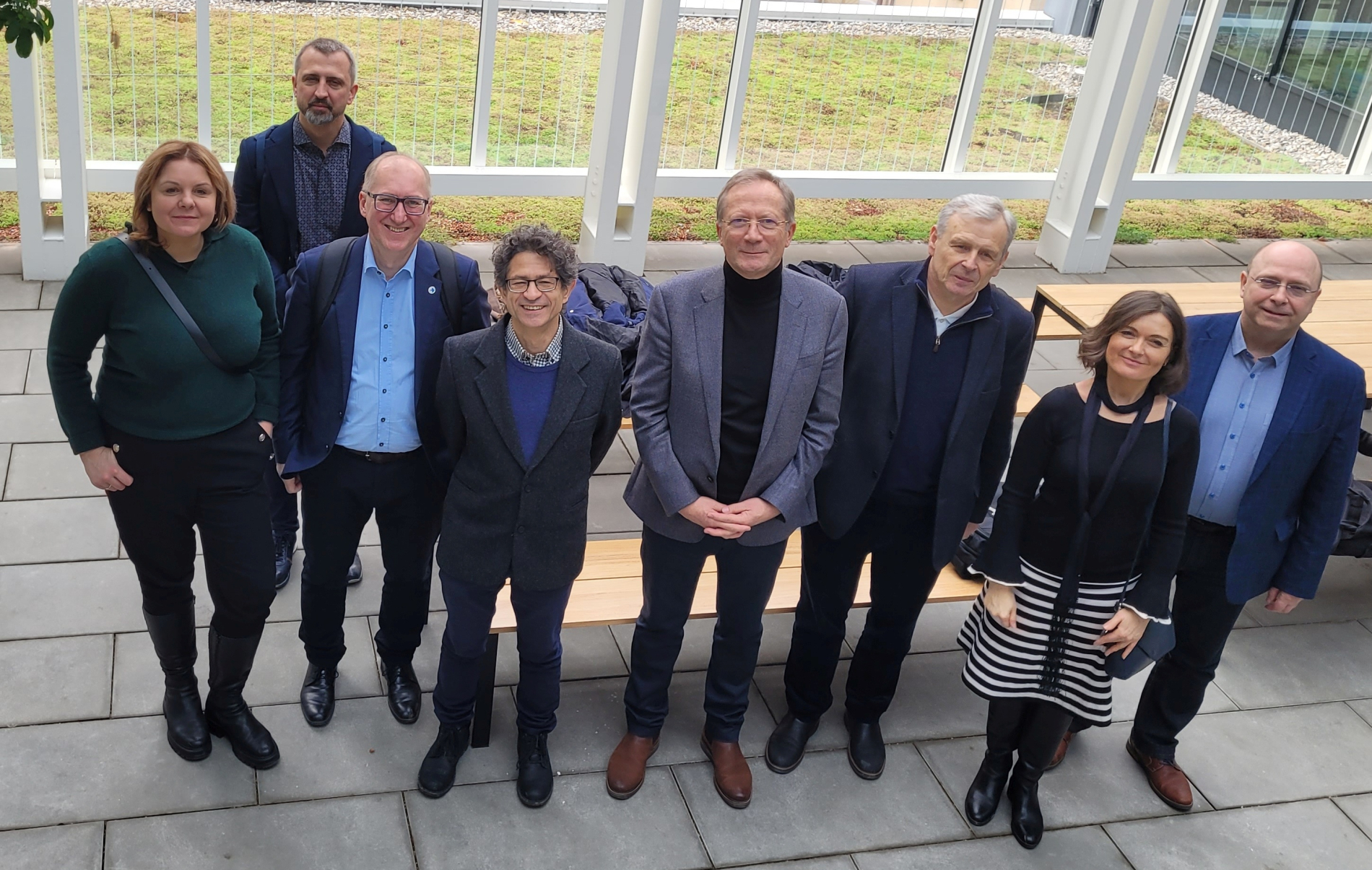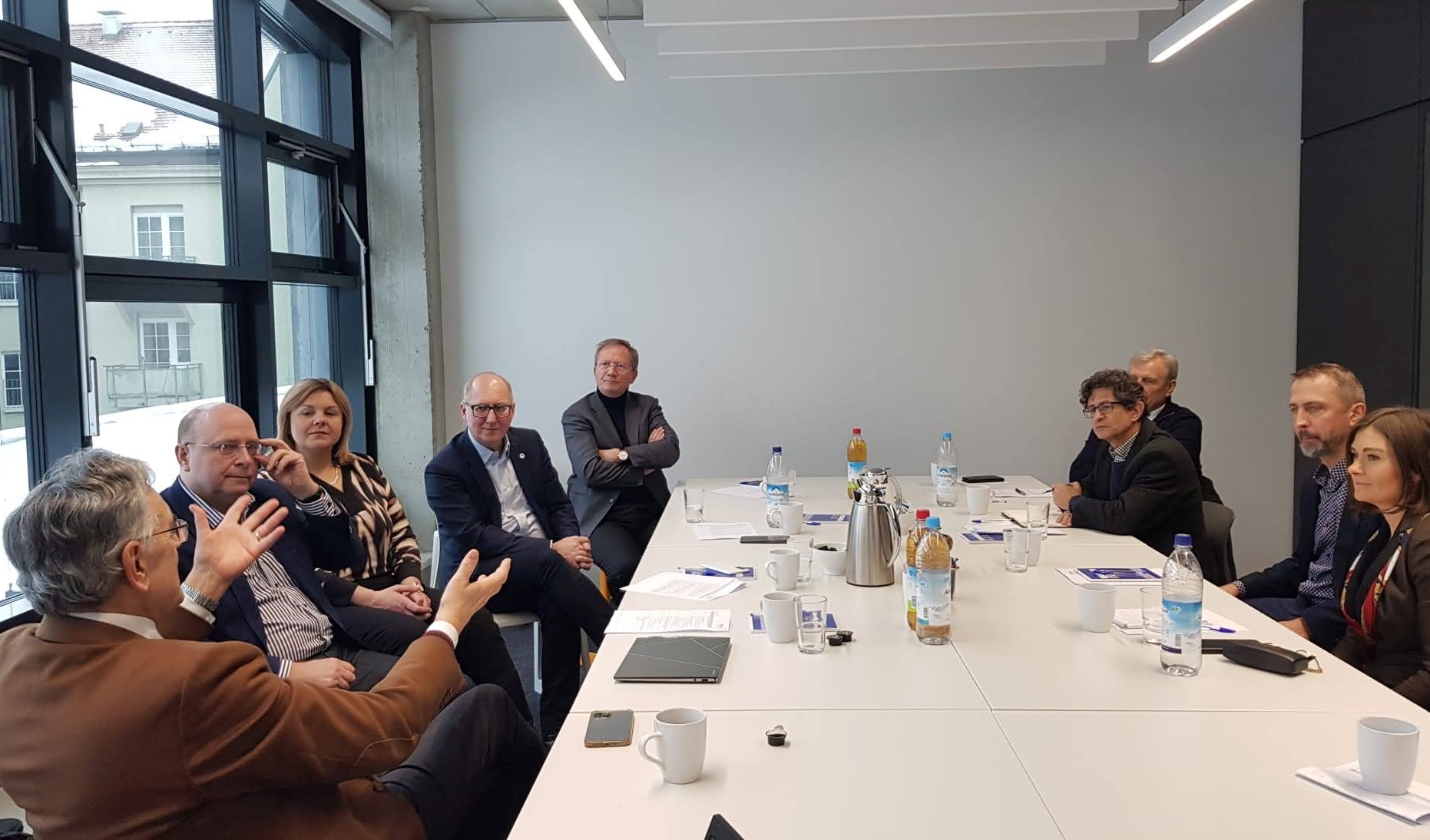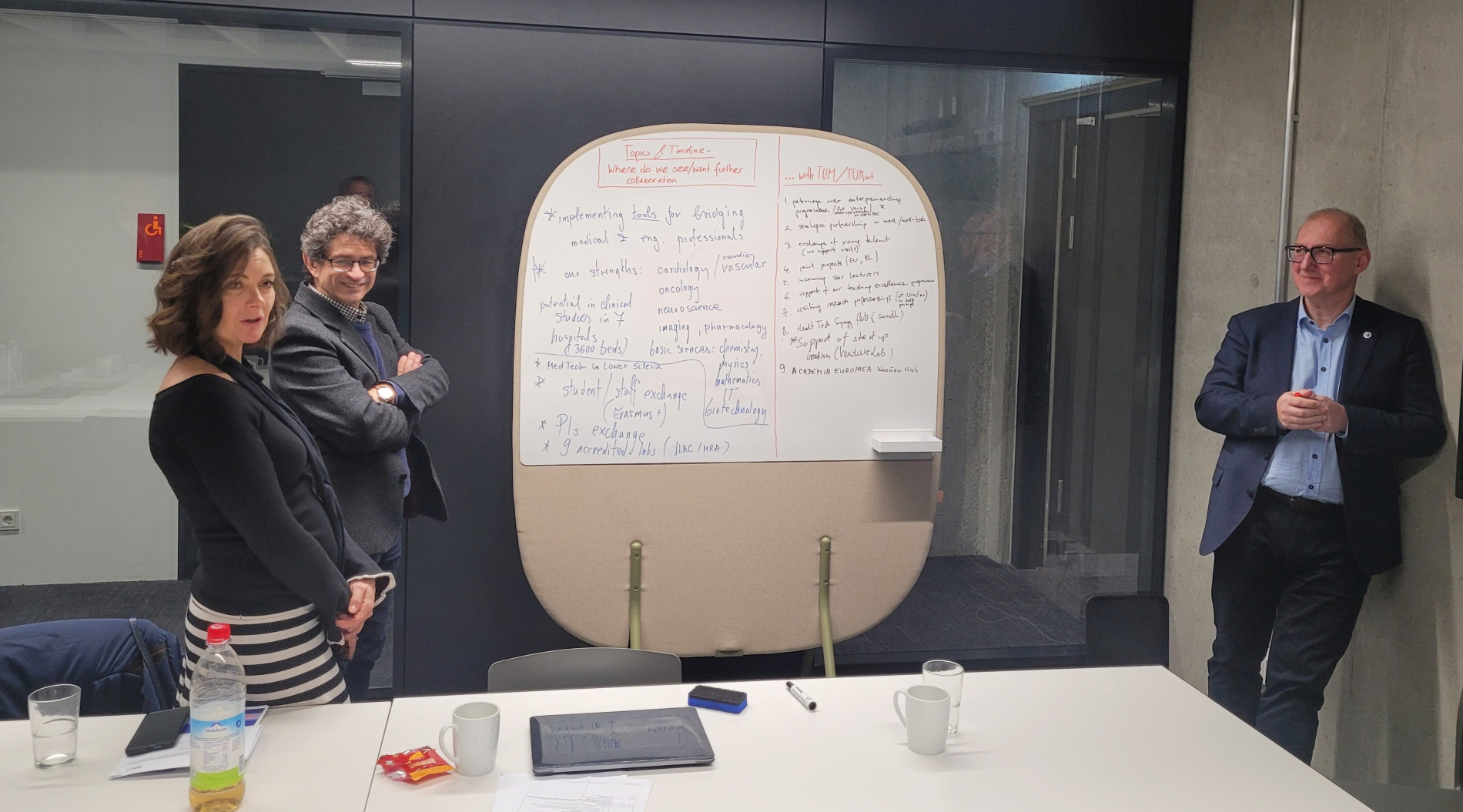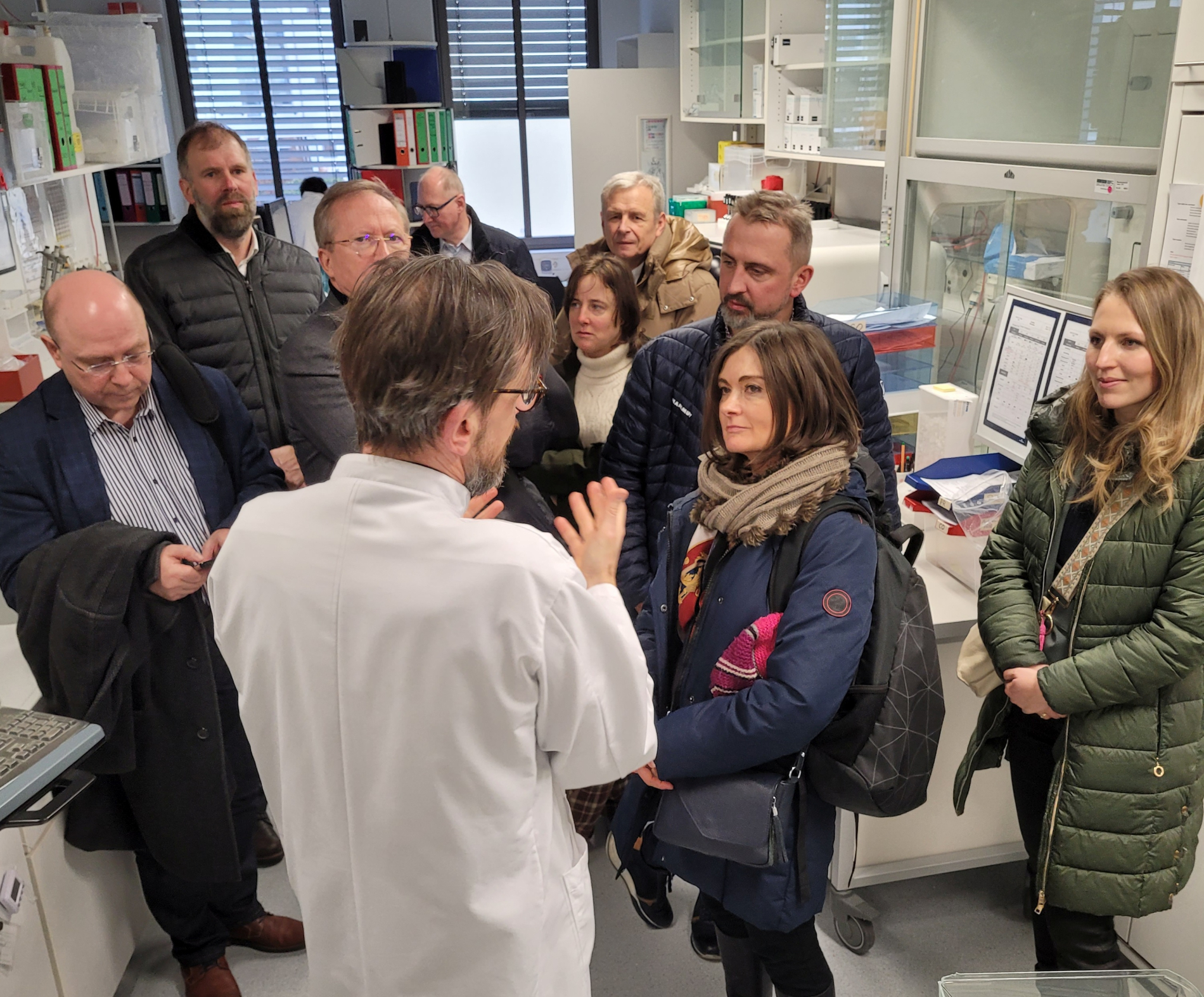YOUR BROWSER IS OUT-OF-DATE.
We have detected that you are using an outdated browser. Our service may not work properly for you. We recommend upgrading or switching to another browser.
Date: 25.01.2024 Category: general news, international cooperation

Wrocław University of Science and Technology is the first Polish technical university to train future doctors. What is a novelty in our country is widespread practice in the West. At the Technical University of Munich (TUM), the combination of medicine and engineering is producing spectacular results. A delegation from Wrocław Tech has visited the German university to learn about its solutions and practices.
In Munich, the capital of Bavaria, medicine has been one of the fields of study at Ludwig-Maximilians-University (LMU)) for 550 years. In 1968, however, the local technical university decided to establish its own Faculty of Medicine. The process was far from easy. “There were concerns about the funding of the other faculties,” recalls Prof. Wolfgang A. Herrmann, former Rector of TUM. “Even the university senate was against this decision at the very beginning.”
 The Technical University of Munich is recognised as one of Europe’s leading tertiary institutions of this kind with staff comprising as many as 16 Nobel Prize winners (for chemistry, physics, and medicine). This university, like Wrocław University of Science and Technology, is characterised by the diversity of its faculties, which encourages interdisciplinary collaboration.
The Technical University of Munich is recognised as one of Europe’s leading tertiary institutions of this kind with staff comprising as many as 16 Nobel Prize winners (for chemistry, physics, and medicine). This university, like Wrocław University of Science and Technology, is characterised by the diversity of its faculties, which encourages interdisciplinary collaboration.
Today, the training of future doctors in Germany is provided by institutions including technical universities in Dresden, Hanover, and Aachen. “The borderline between engineering and medicine is very attractive scientifically,” admits Prof. Arkadiusz Wójs, Wrocław Tech Rector. “Also, engineers need to have humanising contact with other areas of science in the education process, and it’s important for future doctors to be educated in access to technology,” adds Prof. Wójs.
An eight-strong delegation from Wrocław Tech went to Munich at the invitation of the authorities of the said tertiary institution. In addition to our Rector, Prof. Arkadiusz Wójs, the group included Prof. Dariusz Łydżba, Vice-Rector for Cooperation, Dariusz Jagielski, PhD, Eng., Professor of the University, Dean of the Faculty of Medicine, Prof. Tomasz Roleder, Vice-Dean for Clinical Affairs and Science at the Faculty of Medicine, Prof. Waldemar Banasiak, Chairman of the Science Discipline Council for Medical Sciences, Prof. Robert Iskander. Director of the HealthTech Synergy Hub, Prof. Katarzyna Chojnacka, Rector's Plenipotentiary for European Cooperation, and Anna Górecka, PhD, Director of the Academic Entrepreneurship Incubator.
The three-day visit focused on developing innovative educational programmes, fostering innovation and entrepreneurship, and conducting translation research that impacts clinical practice. These experiences are intended to inspire the development of Wrocław Tech’s Faculty of Medicine, particularly in digital medicine, the use of data, and artificial intelligence in diagnosis and therapy.

“Our attention was drawn to innovative teaching methods, including the use of 3D, augmented reality, and virtual reality technologies in medical education, especially anatomy,” says the Dean of the Faculty of Medicine at Wrocław Tech, Professor of the University Dariusz Jagielski, PhD. “This kind of combination of traditional and modern educational techniques demonstrates how technology can enrich the classic approach to learning to make it more interactive and accessible to students.
Among other facilities, the local technical university has a Centre for Medical Education, known for its innovative curricula. Students have the opportunity to learn anatomy both in a classic format and using advanced digital tools. There, the use of digital techniques has a special role in the teaching of anatomy. These include 3D printing, augmented reality (AR), and virtual reality (VR), which enable students to understand the structure and function of different elements of human anatomy in a way that differs from traditional teaching methods.
Collaboration between engineers and doctors at TUM results in solutions that improve the precision, safety, and efficiency of medical procedures.
 As a result of physicists’ and chemists’ efforts, medical innovations have been developed, including advanced diagnostic techniques such as MRI technology. A dedicated neuroengineering unit integrates electronic engineering with neurology. Interdisciplinary research in nuclear medicine plays a key role in cancer treatment. Knowledge that pertains to the areas of physics, biology, chemistry, and engineering is being used to develop advanced techniques for precise imaging of tumour lesions and targeting radioisotope therapy directly to cancer cells.
As a result of physicists’ and chemists’ efforts, medical innovations have been developed, including advanced diagnostic techniques such as MRI technology. A dedicated neuroengineering unit integrates electronic engineering with neurology. Interdisciplinary research in nuclear medicine plays a key role in cancer treatment. Knowledge that pertains to the areas of physics, biology, chemistry, and engineering is being used to develop advanced techniques for precise imaging of tumour lesions and targeting radioisotope therapy directly to cancer cells.
“We must remember that these spectacular successes are the fruit of decades of work," points out Prof. Waldemar Banasiak, Chairman of the Medical Sciences Discipline at Wrocław Tech. “As far as we’re concerned, now we should rather build on our strengths in medicine, such as cardiovascular or oncology issues or topics related to imaging or pharmacology, and invite engineers to joint projects in these areas.”
The Wrocław Tech delegation met leading experts from TUM and other local academic centres. These included Prof. Wolfgang A. Herrmann (former long-serving Rector of TUM), Prof. Nikolai Klymiuk (TUM School of Medicine and Health), Prof. Thomas Gudermann (Dean of the Faculty of Medicine at LMU) and Prof. Markus Schwaiger (former Director for Medicine and Chairman of the Board of Klinikum rechts der Isar at TUM). Our representatives also took a tour of the Munich Urban Colab, an innovative start-up centre for smart city solutions, and participated in interactive sessions with employees of the TUM Venture Lab Healthcare and the TUM Centre for Medical Education.
“I’m certain that the time spent in Munich will inspire us to take further steps in the development of the Faculty of Medicine," says Prof. Katarzyna Chojnacka. “This collaboration opens up new horizons in education, research, and clinical practice while being a major step towards further developing the university at the interface between medicine and technology. And thus, towards strengthening Wrocław Tech's position in innovation and interdisciplinary research, both nationally and internationally,” adds Prof. Chojnacka.

***The Faculty of Medicine of Wrocław University of Science and Technology
We currently have 60 students in the medical degree programme of Wrocław Tech’s Faculty of Medicine. Each of them has a tutor, starting from the first semester of their studies, who is an experienced doctor, and the tutoring sessions are also held at partner hospitals.
Students study under the guidance of 69 academics, including 16 titular professors and 19 professors of the university. The faculty also employs 12 people in administration and seven experts in various medical fields. Preclinical subjects included in the medical degree programme are taught by an additional 60 academics employed at other Wrocław Tech faculties.
The target is to increase the number of teachers at the Faculty of Medicine to at least 250 academics specialised in medical and health sciences. Only recently have we strengthened our unit with qualified medical staff including an anatomist, a pathomorphologist, and specialists with many years of experience in clinical work and teaching normal anatomy.
The training is delivered following current teaching standards in modern laboratories and hospitals. Among other things, we have the most modern Virtual Microscopy Laboratory in Poland, equipped with a special 4D image emission system, where we teach histology. Practical classes in “Elements of Nursing and Health Care. Medical First Aid” are already underway. These are carried out at the multispeciality hospitals partnering with Wrocław Tech (where students have direct contact with patients) as well as at the Medical Simulation Centre.
In addition, the faculty has specialised medical laboratories (Topographical Anatomy and Human Physiology; Human Physiology, Normal and Topographical Anatomy, Virtual Prosectorium – Live Tissue Dissection Laboratory; and Virtual Microscopy). To cater to the needs of the medical degree programme, W14 students and staff also have access to the university's laboratories including Biophysics Laboratory, Biochemistry Laboratory, Biological Chemistry Laboratory, and Bioimaging Laboratory.
There will be more laboratories and workrooms as the research and teaching offer develops, in line with the strategic plan to build a full-scale Collegium Medicum at the university.
Our students have access to two dissection rooms in the 4th Military Clinical Hospital in Wrocław and J. Gromkowski Regional Specialist Hospital in Wrocław.
All the necessary preparations, such as bone models, models of individual anatomical structures, and whole bodies, have been purchased for classes in normal anatomy with elements of topographical anatomy. We also have a state-of-the-art interactive 3D anatomy application in Polish and have commissioned so-called cadaveric bodies, i.e. human bodies fixed in the plastination process. These will be delivered in March 2024.
We have a full list of textbooks described in the subject sheets, i.e. 400 printed titles (around 900 copies) and 300 e-books (according to syllabuses or suggestions). Moreover, we have gained access to the AccessMedicine database (which includes 170 textbooks).
Our site uses cookies. By continuing to browse the site you agree to our use of cookies in accordance with current browser settings. You can change at any time.